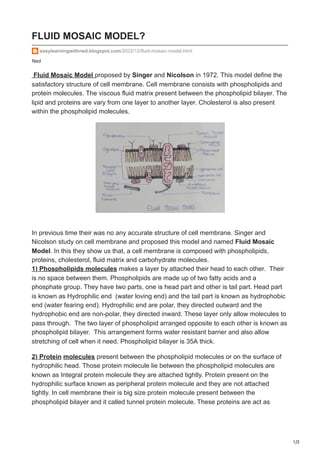easylearningwithned.blogspot.com-FLUID MOSAIC MODEL.pdf
•
1 like•6 views
What is Fluid Mosaic Model.
Report
Share
Report
Share
Download to read offline

Recommended
More Related Content
Similar to easylearningwithned.blogspot.com-FLUID MOSAIC MODEL.pdf
Similar to easylearningwithned.blogspot.com-FLUID MOSAIC MODEL.pdf (20)
Structure, composition of plasma membrane by muhammad akmal bhikh

Structure, composition of plasma membrane by muhammad akmal bhikh
This is a Physiology qquestion. Describe the two general meanings of.pdf

This is a Physiology qquestion. Describe the two general meanings of.pdf
The current model of cellular membranes is called PB and J sandwich.pdf

The current model of cellular membranes is called PB and J sandwich.pdf
More from Home
More from Home (11)
easylearningwithned.blogspot.com-Difference between Osmosis and Diffusion.pdf

easylearningwithned.blogspot.com-Difference between Osmosis and Diffusion.pdf
easylearningwithned.blogspot.com-What is Endoplasmic Reticulum ER (1).pdf

easylearningwithned.blogspot.com-What is Endoplasmic Reticulum ER (1).pdf
easylearningwithned.blogspot.com-What is Golgi Apparatus Location Structure...

easylearningwithned.blogspot.com-What is Golgi Apparatus Location Structure...
easylearningwithned.blogspot.com-What is Lysosomes Origin and Occurrence Morp...

easylearningwithned.blogspot.com-What is Lysosomes Origin and Occurrence Morp...
easylearningwithned.blogspot.com-What is Microbodies their structure types an...

easylearningwithned.blogspot.com-What is Microbodies their structure types an...
easylearningwithned.blogspot.com-What are Mitochondria Structure and Function...

easylearningwithned.blogspot.com-What are Mitochondria Structure and Function...
easylearningwithned.blogspot.com-What is Nucleus Explained its structure and...

easylearningwithned.blogspot.com-What is Nucleus Explained its structure and...
easylearningwithned.blogspot.com-What is CELL Discovery Types structure and F...

easylearningwithned.blogspot.com-What is CELL Discovery Types structure and F...
easylearningwithned.blogspot.com-How molecules transport across the Cell Memb...

easylearningwithned.blogspot.com-How molecules transport across the Cell Memb...
Recently uploaded
Recently uploaded (20)
Porella : features, morphology, anatomy, reproduction etc.

Porella : features, morphology, anatomy, reproduction etc.
FAIRSpectra - Enabling the FAIRification of Spectroscopy and Spectrometry

FAIRSpectra - Enabling the FAIRification of Spectroscopy and Spectrometry
Cot curve, melting temperature, unique and repetitive DNA

Cot curve, melting temperature, unique and repetitive DNA
Module for Grade 9 for Asynchronous/Distance learning

Module for Grade 9 for Asynchronous/Distance learning
X-rays from a Central “Exhaust Vent” of the Galactic Center Chimney

X-rays from a Central “Exhaust Vent” of the Galactic Center Chimney
Role of AI in seed science Predictive modelling and Beyond.pptx

Role of AI in seed science Predictive modelling and Beyond.pptx
LUNULARIA -features, morphology, anatomy ,reproduction etc.

LUNULARIA -features, morphology, anatomy ,reproduction etc.
COMPOSTING : types of compost, merits and demerits

COMPOSTING : types of compost, merits and demerits
Climate Change Impacts on Terrestrial and Aquatic Ecosystems.pptx

Climate Change Impacts on Terrestrial and Aquatic Ecosystems.pptx
Thyroid Physiology_Dr.E. Muralinath_ Associate Professor

Thyroid Physiology_Dr.E. Muralinath_ Associate Professor
POGONATUM : morphology, anatomy, reproduction etc.

POGONATUM : morphology, anatomy, reproduction etc.
easylearningwithned.blogspot.com-FLUID MOSAIC MODEL.pdf
- 1. 1/2 Ned FLUID MOSAIC MODEL? easylearningwithned.blogspot.com/2022/12/fluid-mosaic-model.html Fluid Mosaic Model proposed by Singer and Nicolson in 1972. This model define the satisfactory structure of cell membrane. Cell membrane consists with phospholipids and protein molecules. The viscous fluid matrix present between the phospholipid bilayer. The lipid and proteins are vary from one layer to another layer. Cholesterol is also present within the phospholipid molecules. In previous time their was no any accurate structure of cell membrane. Singer and Nicolson study on cell membrane and proposed this model and named Fluid Mosaic Model. In this they show us that, a cell membrane is composed with phospholipids, proteins, cholesterol, fluid matrix and carbohydrate molecules. 1) Phospholipids molecules makes a layer by attached their head to each other. Their is no space between them. Phospholipids are made up of two fatty acids and a phosphate group. They have two parts, one is head part and other is tail part. Head part is known as Hydrophilic end (water loving end) and the tail part is known as hydrophobic end (water fearing end). Hydrophilic end are polar, they directed outward and the hydrophobic end are non-polar, they directed inward. These layer only allow molecules to pass through. The two layer of phospholipid arranged opposite to each other is known as phospholipid bilayer. This arrangement forms water resistant barrier and also allow stretching of cell when it need. Phospholipid bilayer is 35A thick. 2) Protein molecules present between the phospholipid molecules or on the surface of hydrophilic head. Those protein molecule lie between the phospholipid molecules are known as Integral protein molecule they are attached tightly. Protein present on the hydrophilic surface known as peripheral protein molecule and they are not attached tightly. In cell membrane their is big size protein molecule present between the phospholipid bilayer and it called tunnel protein molecule. These proteins are act as
- 2. 2/2 carrier molecules. They carry the specific molecules and allow to transport inside or outside of the cell. It provide a path for selective material exchange from cell to extracellular fluid and also control the flow of material. 3) Cholesterol- these molecules present between the phospholipid molecules. A good amount of cholesterol present in animal cell membrane. It helps to stabilize the cell membrane. 4) Oligosaccharide (Carbohydrate molecule)- The branched shaped molecules present on cell membrane is known as carbohydrate molecules. These are attached with protein molecules and phospholipid molecule. The oligosaccharides attached with peripheral protein molecule known as glycoprotein and if the oligosaccharide attached with hydrophilic end is known as glycolipid. The glycoprotein is act as receptor. This is the simple explanation of Fluid Mosaic Model. Some Important Questions. Q1) What is Tunnel protein molecule? Ans. The largest protein molecule lie between the phospholipid bilayers are known as tunnel protein. Q2) Who proposed the Fluid Mosaic Model and when? Ans. In 1972, Singer and Nicolson proposed the fluid mosaic model. Who is the Father of Biology ? What is the unit of Living organism ? What is CELL? Discovery, Types, structure and Functions of cell?
